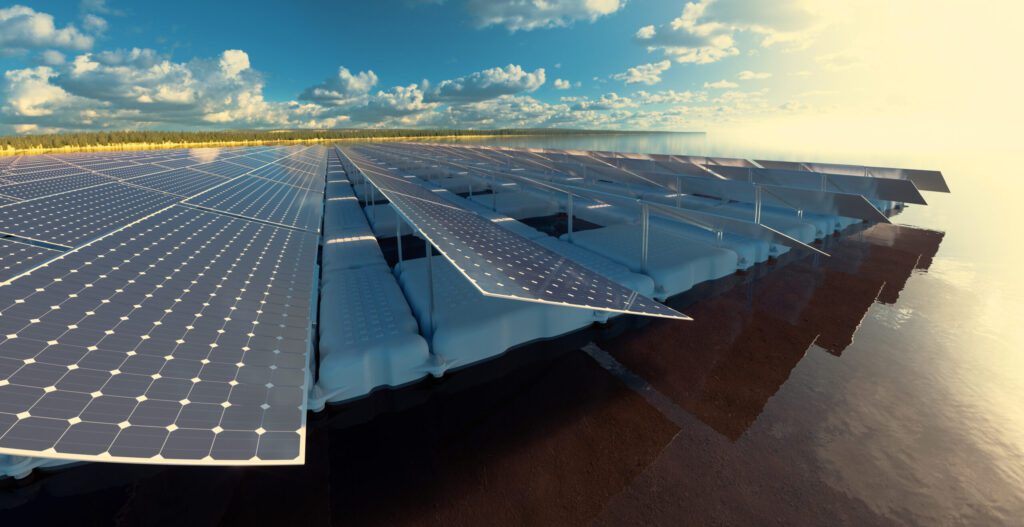Floating Solar Panels Introduce New Possibilities for Ag
by PAMELA PALONGUE
Many people, including those in the agriculture sector, are embracing a new type of solar power technology that harnesses the sun’s rays without taking up valuable space on land.
That’s just fine with D3Energy, a solar developer of floating solar projects. The term “floating solar” may be a bit of a misnomer, however. The solar panels are actually installed on a rack that is suspended about 18 to 24 inches over bodies of water and do not actually rest on the water itself. D3Energy has been installing these innovative panels for the past six years and has installed more floating solar systems than any other company in the country.
We spoke with Stetson Tchividjian, Director of Business Development for D3Energy, to find out why this is rapidly becoming a trend for farmers and ranchers.
One of the most obvious reasons people are turning to solar in general is because it’s more economical in the long run and is, of course, great for the planet. But floating solar is a new way to maximize the benefits by installing the panels over water, rather than land.
“The big thing I’d like to stress about floating solar, is that it is the same solar panels that are used on land. It is the exact same equipment, except for the racking,” explains Tchividjian.
The racks, however, are the secret sauce. They allow the use of still bodies of water, such as drinking reservoirs, quarry lakes, stock ponds and retention ponds, to be used as a platform for the solar panels. In Florida specifically, land is in short supply and comes at a premium. By utilizing these bodies of water, farmers and ranchers can take advantage of the savings of solar without sacrificing dry land used for growing and grazing. Also, by placing the panels over the water, there is a reduction in evaporation of about 50 to 70% in the retention and stock ponds.
Another benefit of placing the panels over water is the cooling effect of the water on the panel. The hotter a panel becomes, the less efficient it is at generating electricity. Stetson says they have seen upwards of a 20% increase in energy production by placing the panels on water. With the extreme Florida heat, the increase in power has been more moderate but still substantial with increases measuring roughly 6-8%. They continue to collect data, however, and the bump in power does vary between specific sites.
Another advantage of floating solar is that the panels stay much cleaner over water, which also helps increase their efficiency for maximum solar collection.
Farmers can expect to see lower operation and maintenance costs, as well as installation on the front end. Land-based solar panels may require fencing to protect them, which is not the case when installed over water.
There are also federal incentives with a tax credit of 26% back on installation, which has been extended through 2022, and an additional 100% depreciation credit that is available in the first year.
“We’ve seen a huge jump here lately in installations of floating solar in the ag industry in particular,” Tchividjian explains. “The ag industry has been one of our main focuses of late. We’re talking to some large meat farms, and they’re saving roughly half the cost of operation and maintenance,” he notes.
There are some obvious questions that arise when considering the floating solar option. For example, electricity and water are not always the best of friends. However, Tchividjian explains that the whole system is wired so that if it is ever tripped, all of the associated electrical shuts down.
“There’s no hazard that the water can become electrified. We use the same technology that is used for docks that are lit.”
If you’re concerned about its effect on fish and birds, studies have found that there have been no adverse effects on wildlife.
“We won’t cover more than 70 percent of a body of water. We’ve found that the fish like to migrate underneath it.”
Another mitigating factor is that it is not a solid, continuous voltaic panel. It’s more like a checkerboard square with spaces in between. If a bird or other animal is under the panels, there is ample room for them to surface, with no fear of them becoming trapped underneath the panels.
Tchividjian adds that in his experience, the panels actually help to reduce algae. And there is no radiation with solar energy, making it even more attractive.
Stetson describes D3Energy as a developer that provides a turn-key operation to the client. “We can install any type of panels on these floats, bifacial/monofacial panels – whatever works best for the client.”
Luckily, the company has not experienced many of the supply chain issues that plague so many industries right now. Its products are all manufactured in the U.S., in Atlanta and Texas to be exact, which makes it much easier for them to get materials to install. It recently completed a project for the U.S. Army and is working with the U.S. Department of Energy on the benefits of floating solar systems.
“It’s really exciting to see the growth of this in the ag industry,” adds Tchividjian.

